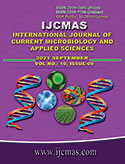


 National Academy of Agricultural Sciences (NAAS)
National Academy of Agricultural Sciences (NAAS)

|
PRINT ISSN : 2319-7692
Online ISSN : 2319-7706 Issues : 12 per year Publisher : Excellent Publishers Email : editorijcmas@gmail.com / submit@ijcmas.com Editor-in-chief: Dr.M.Prakash Index Copernicus ICV 2018: 95.39 NAAS RATING 2020: 5.38 |
The research on, ‘Studies on rainwater harvesting and reutilization for protective irrigation with farm pond’ was conducted during the year 2016-17 at demonstration farm of the Vasantrao Naik Marathwada Krishi Vidyapeeth, Parbhani. The daily depth of water impounded in the farm pond was recorded for developing stage-storage relationship of the farm pond. For estimation of the loss of water through evaporation from farm pond, daily pan evaporation data was multiplied by pan co-efficient (0.70). The harvested water in the farm pond was utilized for applying protective irrigation to the pigeon pea crop. The experiment consisted six replications and two treatments. One protective irrigation for pigeon pea at pod development stage (T1) was applied on 30.11.2016. The treatment T2 consisted without protective irrigation to pigeon pea. The grain yield of pigeon pea was recorded plot wise.The grain yield data was analyzed using MAUSTAT software and results obtained were compared treatment wise. For economic analysis of the treatments, cost of cultivation, cost of cultural operations, fixed and operational costs of pump and accessories were calculated. These total cost was be used to determine the gross monetary returns (GMR), net monetary returns (NMR) and benefit cost ratio (B:C ratio). The area of top section and bottom section of the farm pond was 279.75 m2 and 516.82 m2 respectively. The average elevation of embankment at top was 413.130m. The average elevation of bottom of pond was 410.210m. The elevation at the bottom of outlet was 412.437m. The maximum depth of water impounded and maximum storage volume in the farm pond was 2.165m and 933.99m3 respectively. The total water evaporated through farm pond for the month of July, August, September, October, November and December 2016 was found to be 19.14 m3, 32.60m3, 25.40 m3, 35.9882m3, 29.8620m3 and 1.1965 m3 respectively. The maximum water evaporated through the farm pond was recorded in the month of October-2016. Total evaporation loss through the farm pond recorded was144.17 m3.The seepage loss through the pond for the month of July August, September, October, November and December 2016 was found to 634.88, 358.05 m3, 651.80 m3, 611.64 m3, 147.33 m3, and 37.89 m3 respectively. The maximum water seepage through the farm pond was recorded in the month of September -2016.The total seepage loss recorded through the farm pond was 2441.59 m3. The harvested water in the farm pond was utilized for irrigating the pigeon pea crop at its pod development stage. One of protective irrigation (T1) recorded significantly higher pigeon pea grain yield than treatment of without protective irrigation (T2). Due to the one protective irrigation, 27.30 per cent grain yield increased over or control was observed. The study revealed that the treatment T1 i. e. one protective irrigations at pod development stage recorded highest GMR (111302.00Rs/ha) and NMR (76302.00) as compared to control (T2) i. e. without protective irrigation. The benefit- cost ratio (2.18) is found to be higher under the treatment T1i. e. one protective irrigation pod development stage. The lowest B:C ratio (1.69) is estimated under the treatment T2 (without protective irrigation).
 |
 |
 |
 |
 |